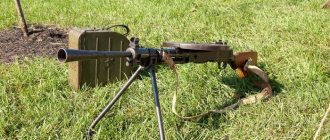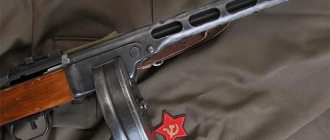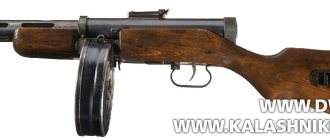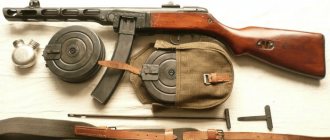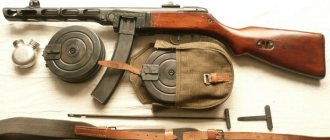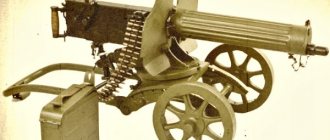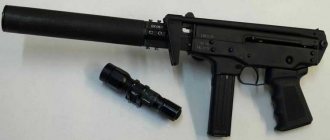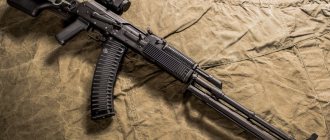The DShK heavy machine gun was created in the USSR even before the start of the Great Patriotic War. Despite its venerable age, this weapon turned out to be so effective that it is still used in the armies of dozens of countries around the world.
Having gone through the Second World War from beginning to end, the DShK participated in almost all subsequent military conflicts in the world. Having shown his outstanding qualities during the Second World War, he brilliantly demonstrated them during the war in Afghanistan. The last use of this assault machine gun was recorded during the Syrian war and the conflict in eastern Ukraine.
Development of the first heavy machine gun in the USSR
After the Civil War ended in the USSR, the leadership of the Workers 'and Peasants' Red Army was faced with the question of creating a heavy machine gun, since this weapon niche was completely empty. The designers were tasked with creating a powerful 12-20 mm machine gun. Beginning in 1925, the 12.7 mm cartridge was chosen as the main caliber. The first attempts of Soviet designers cannot be called successful, since until 1931, none of the presented models could pass tests.
Only at the beginning of 1931 the commission received two samples of heavy machine guns that deserved attention:
- Draize system machine gun;
- Machine gun of the Degtyarev system.
The German machine gun did not perform well; moreover, it was difficult to manufacture, so it was decided to abandon its copying and production. Weapons from Degtyarev proved to be more technologically advanced, so already in 1932 the first attempt was made to begin mass production of these weapons. A year later, the designers managed to create 12 samples of such machine guns, but already in 1934 production was practically curtailed. The Degtyarev machine gun did not perform well in the army. It would seem that the fate of the DK machine gun, which stood for “Degtyarev large-caliber,” was a foregone conclusion.
The rebirth of the Degtyarev machine gun
Military tests showed that the new weapon was completely unsuitable for combating high-speed targets, and it was supposed to be used as an anti-aircraft machine gun. The weapon had the following disadvantages:
- Extremely low rate of fire;
- Heavy weight;
- Heavy and inconvenient cartridge magazines.
In 1935, a decree was issued to stop the production of new weapons. The machine gun was revived thanks to the talented Soviet gunsmith designer Shpagin, who became interested in the promising development. He was able to invent a new tape feeding mechanism in 1937. The following year, a new machine gun, called DShK (Degtyarev-Shpagin large-caliber), successfully passed tests, and in 1939 its mass production began.
Modifications
- DShKT - a tank machine gun, was first installed on IS-2 tanks as an anti-aircraft gun
- DShKM-2B - a twin installation for armored boats, where two machine guns were installed in a closed turret, with bulletproof armor
- MTU-2 - twin turret unit weighing 160 kg, designed for installation on ships
- DShKM-4 – pilot quad installation
- P-2K - a silo installation created for submarines (during the trip it was removed inside the boat)
Video about the DShK machine gun
Weapon Features
The DShK machine gun has the following design features:
- The automation operates according to a standard scheme using powder gases. A special feature of the system is the presence of three holes in the gas chamber. Due to the regulator, it was possible to adjust the amount of powder gases, adjusting the operation of the weapon’s automation;
- The machine gun barrel received ribs along its entire length; they were intended to prevent overheating. The muzzle of the weapon received a specific muzzle brake in the form of a parachute. After some time, the muzzle brake became flat;
- The machine gun barrel bore was reliably locked due to the combat stops, the design feature of which was that they were moved in different directions;
- The gas piston rod was equipped with a return spring. Due to the spring shock absorbers, which were located in the butt plate of the machine gun, it was possible not only to significantly reduce recoil, but also to significantly increase the service life of the weapon. In addition, these shock absorbers played another important role - they accelerated the reverse movement of the bolt frame. It was thanks to this design feature that the rate of fire was significantly increased.
Since the new machine gun “jumped” a lot due to the peculiarities of its design, it was soon equipped with a special device that dampened the rebound.
Design Features
The DShK heavy machine gun (12.7 mm caliber) is an automatic weapon that uses the principle of removing powder gases. The DShK fire mode is automatic only, the fixed barrel is equipped with a muzzle brake and has special fins for better cooling. The barrel is locked by two combat cylinders, which are hinged on the bolt.
The feed is made from a metal non-scattered tape; the tape is fed from the left side of the DShK. The tape feeder is made in the form of a drum. As the drum rotated, it simultaneously fed the belt and also removed cartridges from it (the belt had open links). After the chamber of the drum with the cartridge came to the lower position, the bolt fed the cartridge into the chamber.
The tape was fed using a lever located on the right side and swinging in a vertical plane during the action of the loading handle, rigidly connected to the bolt frame.
The drum mechanism of the DShKM was replaced with a compact slider mechanism, which worked on a similar principle. The cartridge was removed from the tape downwards, after which it was fed directly into the chamber. Spring buffers for the bolt frame and bolt are installed in the buttplate of the receiver. The fire is fired from the rear sear. To control the fire, two handles are used on the butt plate, as well as twin triggers. For aiming, a frame sight was installed, and special mounts were installed for the anti-aircraft foreshortening sight.
The machine gun was mounted on a universal machine of the Kolesnikov system, which was equipped with a steel shield and removable wheels. When using the machine gun as an anti-aircraft gun, the rear support was folded into a tripod, and the wheels and shield were removed. The main disadvantage of this machine was its weight, which limited the mobility of the machine gun. The machine gun was installed:
- on ship pedestal installations;
- in tower installations;
- on remote-controlled anti-aircraft installations.
Features of shooting from a DShK and reloading weapons
The handle for reloading the weapon has a rigid coupling with the bolt frame. A special mechanism for reloading the system also interacts with the frame, although if you insert the cartridge with the case head, you can completely do without it. The DShK machine gun is capable of firing only in automatic mode. For safe handling of the weapon, the design includes a flag-type fuse, which when placed on it completely blocks the trigger.
The principle of operation when shooting is implemented as follows:
- The bolt stops when it comes close to the breech of the barrel. The shutter frame continues its movement;
- Due to the thickening on the firing pin, the lugs are cocked. They fit into recesses that are specially designed for this purpose;
- The barrel locks, but the bolt carrier continues to move forward. The frame striker hits the striker;
- When the bolt frame moves back, the bolt is unlocked.
Then the entire algorithm is repeated.
Features of the ammunition supply of a heavy machine gun
The DShK's ammunition supply comes from a metal link belt on the left side of the weapon. For ease of use, the tape is folded into a special metal container, which is attached directly to the machine gun mount. The drum belt receiver on the machine gun operates due to the handle of the bolt frame. The feeder lever is equipped with a special “dog”, which rotates the receiver drum 60 degrees. Due to this, the cartridge strip was stretched.
As for the ammunition that was used on the DShK machine gun, they had a wide range of names, ranging from armor-piercing to incendiary.
Sights DShK
Until 1938, a simple folding frame sight was installed on the machine gun. Its main purpose was to shoot at enemy personnel and lightly armored ground vehicles. Other types of sights appeared later:
- In 1938, a ring anti-aircraft sight was installed on the DShK. With its help it was possible to shoot at enemy aircraft located at a distance of up to 2,400 meters. In this case, the target speed should not exceed 500 km/h;
- In 1941, the anti-aircraft sighting device underwent modernization, which greatly simplified it. Now fire could be fired at targets whose speed could be 625 km/h. The distance to the target decreased to 1,800 meters, but in fact, effective shooting was carried out at distances not exceeding 1,500 meters, so this characteristic did not change anything;
- Since during the Second World War the DShK was most often used as a weapon to combat enemy aircraft, a new type of anti-aircraft sight appeared in 1943. The new device helped to conduct effective fire at enemy aircraft even during their dive.
Soon they tried to make a special anti-aircraft machine gun based on the DShK machine gun.
Shooting from a DShK machine gun - video
With the start of work on a machine gun with a caliber of 12-20 millimeters in 1925, it was decided to create it on the basis of a magazine-fed light machine gun in order to reduce the weight of the machine gun being created. Work began at the design bureau of the Tula Arms Plant on the basis of the 12.7-mm Vickers cartridge and on the basis of the German Dreyse (P-5) machine gun. The design bureau of the Kovrov plant was developing a machine gun based on the Degtyarev light machine gun for more powerful cartridges. A new 12.7-mm cartridge with an armor-piercing bullet was created in 1930, and at the end of the year the first experimental large-caliber Degtyarev machine gun with a Kladov disc magazine with a capacity of 30 rounds was assembled. In February 1931, after testing, preference was given to the DK (“Degtyarev large-caliber”) as easier to manufacture and lighter. The recreation center was put into service; in 1932, a small series was produced at the plant named after. Kirkizha (Kovrov), however, in 1933 only 12 machine guns were produced.
Military tests did not live up to expectations. In 1935, production of the Degtyarev heavy machine gun was stopped. By this time, a version of the DAK-32 had been created that had a Shpagin receiver, but tests in 1932-1933 showed the need to refine the system. Shpagin remade his version in 1937. A drum feed mechanism was created that did not require significant changes to the machine gun system. The belt-fed machine gun passed field tests on December 17, 1938. On February 26 of the following year, by resolution of the Defense Committee, they adopted the designation “12.7-mm heavy machine gun mod. 1938 DShK (Degtyarev-Shpagina large-caliber)” which was installed on the Kolesnikov universal machine. Work was also carried out on the DShK aircraft installation, but it soon became clear that a special large-caliber aircraft machine gun was needed.
The automatic operation of the machine gun was carried out due to the removal of powder gases. A closed gas chamber was located under the barrel and was equipped with a pipe regulator. The barrel had fins along its entire length. The muzzle was equipped with a single-chamber active-type muzzle brake. By moving the bolt lugs to the sides, the barrel bore was locked. The ejector and reflector were assembled in the gate. A pair of spring shock absorbers of the butt plate served to soften the impact of the moving system and give it an initial rolling impulse. A return spring, mounted on the gas piston rod, activated the impact mechanism. The trigger lever was blocked by a safety lever mounted on the buttplate (setting the safety to the front position).
Feeding – belt, feeding – from the left side. The loose tape, which has semi-closed links, was placed in a special metal box attached to the left side of the machine bracket. The bolt carrier handle activated the DShK drum receiver: while moving backward, the handle bumped into the fork of the swinging feed lever and turned it. A pawl located at the other end of the lever rotated the drum 60 degrees, and the drum, in turn, pulled the tape. There were four cartridges in the drum at a time. As the drum rotated, the cartridge was gradually squeezed out of the belt link and fed into the receiving window of the receiver. The shutter moving forward caught it.
The folding frame sight, used for firing at ground targets, had a notch of up to 3.5 thousand m in increments of 100 m. The machine gun's markings included the manufacturer's mark, year of manufacture, serial number (series designation - two-letter, serial number of the machine gun) . The mark was placed in front of the butt plate on top of the receiver.
During operation with the DShK, three types of anti-aircraft sights were used. The ring remote sight of the 1938 model was intended to destroy air targets flying at speeds of up to 500 km/h and at a distance of up to 2.4 thousand meters. The sight of the 1941 model was simplified, the range was reduced to 1.8 thousand meters, but the possible speed of the destroyed target increased (along the “imaginary” ring it could be 625 kilometers per hour). The sight of the 1943 model was of the foreshortening type and was much easier to use, but allowed firing at various target courses, including pitching or diving.
The universal Kolesnikov machine of the 1938 model was equipped with its own charging handle, had a removable shoulder pad, a cartridge box bracket, and a rod-type vertical aiming mechanism. Fire at ground targets was carried out from a wheeled vehicle, with the legs folded. To fire at air targets, the wheel drive was separated, and the machine was laid out in the form of a tripod.
The 12.7 mm cartridge could have an armor-piercing bullet (B-30) of the 1930 model, an armor-piercing incendiary bullet (B-32) of the 1932 model, sighting and incendiary (PZ), tracer (T), sighting (P), against anti-aircraft guns targets, an armor-piercing incendiary tracer bullet (BZT) of the 1941 model was used. The armor penetration of the B-32 bullet was 20 millimeters normal from 100 meters and 15 millimeters from 500 meters. The BS-41 bullet, whose core was made of tungsten carbide, was capable of penetrating 20 mm armor plate at an angle of 20 degrees from a range of 750 meters. The dispersion diameter when firing at ground targets was 200 millimeters at a distance of 100 meters.
The machine gun began to enter service with the troops in 1940. In total, in 1940, plant No. 2 in Kovrov produced 566 DShKs. In the first half of 1941 - 234 machine guns (in total, in 1941, with a plan of 4 thousand DShK, about 1.6 thousand were received). In total, as of June 22, 1941, the Red Army units had about 2.2 thousand heavy machine guns.
From the first days of the Second World War, the DShK machine gun proved itself to be an excellent anti-aircraft weapon. So, for example, on July 14, 1941, on the Western Front in the Yartsevo area, a platoon of three machine guns shot down three German bombers; in August, near Leningrad in the Krasnogvardeisky area, the Second Anti-Aircraft Machine Gun Battalion destroyed 33 enemy aircraft. However, the number of 12.7-mm machine gun mounts was clearly not enough, especially considering the enemy's significant air superiority. As of September 10, 1941, there were 394 of them: in the Orel air defense zone - 9, Kharkov - 66, Moscow - 112, on the Southwestern Front - 72, Southern - 58, Northwestern - 37, Western - 27, Karelian - 13.
Since June 1942, the staff of the anti-aircraft artillery regiment of the army included a DShK company, which was armed with 8 machine guns, and since February 1943 their number increased to 16 units. The anti-aircraft artillery divisions of the RVGK (Zenad), formed since November 42, included one such company per anti-aircraft small-caliber artillery regiment. Since the spring of 1943, the number of DShKs in Zenad decreased to 52 units, and according to the updated state of the 44th in the spring, Zenad had 48 DShKs and 88 guns. In 1943, regiments of small-caliber anti-aircraft artillery (16 DShK and 16 guns) were added to the cavalry, mechanized and tank corps.
American infantrymen fire from a DShKM on a Romanian URO VAMTAC during joint US-Romanian maneuvers, 2009
Typically, anti-aircraft DShKs were used by platoons, often included in medium-caliber anti-aircraft batteries, using them to provide cover from air attacks from low altitudes. Anti-aircraft machine gun companies, armed with 18 DShKs, were added to the staff of rifle divisions at the beginning of 1944. Throughout the war, losses of heavy machine guns amounted to about 10 thousand units, that is, 21% of the resource. This was the smallest percentage of losses of the entire small arms system, but it is comparable to losses in anti-aircraft artillery. This already speaks about the role and place of heavy machine guns.
In 1941, as German troops approached Moscow, backup factories were identified in case Factory No. 2 stopped producing weapons. The production of DShK was carried out in the city of Kuibyshev, where 555 devices and machines were transferred from Kovrov. As a result, during the war, the main production took place in Kovrov, and “duplicate” production took place in Kuibyshev.
In addition to easel ones, self-propelled units with DShK were used - mainly M-1 pickups or GAZ-AA trucks with a DShK machine gun installed in the body in the anti-aircraft position on the machine. “Anti-aircraft” light tanks on the T-60 and T-70 chassis did not advance further than prototypes. The same fate befell the integrated installations (although it should be noted that the built-in 12.7-mm anti-aircraft installations were used to a limited extent - for example, they served in the air defense of Moscow). The failures of the installations were associated, first of all, with the power system, which did not allow changing the direction of feed of the tape. But the Red Army successfully used 12.7-mm American quad mounts of the M-17 type based on the M2NV Browning machine gun.
The “anti-tank” role of the DShK machine gun, which received the nickname “Dushka,” was insignificant. The machine gun was used to a limited extent against light armored vehicles. But the DShK became a tank weapon - it was the main armament of the T-40 (amphibious tank), BA-64D (light armored car), in 1944 a 12.7-mm anti-aircraft turret was installed on the IS-2 heavy tank, and later on heavy Self-propelled guns. Anti-aircraft armored trains were armed with DShK machine guns on tripods or stands (during the war, up to 200 armored trains operated in the air defense forces). A DShK with a shield and a folded machine could be dropped to partisans or landing forces in a UPD-MM parachute bag.
The fleet began receiving DShKs in 1940 (at the beginning of the Second World War there were 830 of them). During the war, industry transferred 4,018 DShKs to the fleet, and another 1,146 were transferred from the army. In the navy, anti-aircraft DShKs were installed on all types of ships, including mobilized fishing and transport ships. They were used on twin single pedestals, turrets, and turrets. The pedestal, rack-mount and turret (coaxial) installations for DShK machine guns, adopted by the Navy, were developed by I.S. Leshchinsky, designer of plant No. 2. The pedestal installation allowed for all-round firing, vertical guidance angles ranged from -34 to +85 degrees. In 1939 A.I. Ivashutich, another Kovrov designer, developed a twin pedestal installation, and the later appeared DShKM-2 gave all-round fire. Vertical guidance angles ranged from -10 to +85 degrees. In 1945, the 2M-1 twin deck-mounted installation, which had a ring sight, was put into service. The DShKM-2B twin turret installation, created at TsKB-19 in 1943, and the ShB-K sight made it possible to conduct all-round fire at vertical guidance angles from -10 to +82 degrees.
For boats of various classes, open turret twin installations MSTU, MTU-2 and 2-UK were created with pointing angles from -10 to +85 degrees. The “naval” machine guns themselves differed from the base model. For example, in the turret version, a frame sight was not used (only a ring sight with a weather vane front sight was used), the bolt handle was lengthened, and the hook for the cartridge box was changed. The differences between machine guns for coaxial installations were the design of the butt plate with the frame handle and trigger lever, the absence of sights, and fire control.
The German army, which did not have a standard heavy machine gun, willingly used captured DShKs, which were designated MG.286(r).
At the end of the Second World War, Sokolov and Korov carried out a significant modernization of the DShK. The changes primarily affected the food system. In 1946, a modernized machine gun under the DShKM brand was put into service. The reliability of the system has increased - if on the DShK according to the specifications 0.8% of delays during firing were allowed, then on the DShKM this figure was already 0.36%. The DShKM machine gun has become one of the most widely used in the world.
Production
Iran: licensed production at the Defense Industries Organization under the symbol MGD;
PRC: former manufacturer, produced under the designation Type 54;
Pakistan: produced by Pakistan Ordnance Factories under the designation Type 54;
Romania: as of the beginning of 2015, DShKM is produced at the Kudzhir Mechanical Plant (a branch of the Romarm company) in the city of Kudzhir;
USSR: former manufacturer;
Czechoslovakia: produced under the designation TK vz. 53 (Těžký kulomet vzor 53);
Yugoslavia: former producer
DShK converted into a single-shot sniper rifle
In service
The DShKM was or is in service with over 40 armies around the world, was produced in China (Type 54), is produced in Pakistan, Iran and some other countries. The DShKM machine gun was used as an anti-aircraft gun on Soviet tanks of the post-war period (T-55, T-62) and on armored vehicles (BTR-155). Currently, in the Russian Armed Forces, the DShK and DShKM machine guns have been almost completely replaced by the Utes and Kord large-caliber machine guns, which are more advanced and modern.
Anti-aircraft version of DShK
As a specialized weapon designed specifically to combat aircraft, the machine gun proved to be not a very convenient weapon. Although its power was abundant, the anti-aircraft machine was of a very imperfect type. His stability left much to be desired. It was for this reason that WWII designers tried to develop new anti-aircraft machines for the DShK.
Among these developments there were convenient and functional devices, but their design turned out to be too complex for mass production during the war. That is why at the front one often saw handicrafts of local “Kulibins”, which were not inferior to the factory prototypes, often even surpassing them. Coaxial machine guns were especially popular.
Sometimes there were installations made of three or four machine guns, but due to their weight they were only suitable as defense weapons.
Production of DShK and its combat use
Large-caliber machine guns began to enter the USSR army en masse in 1940. Although the annual production plans for this machine gun did not exceed 1,000 in 1940 and 4,000 in 1941, a completely strange picture was observed in production. In 1940, only 566 pieces were produced. Although next year they were supposed to produce 4 times more machine guns than planned in 1940, in fact the plant was able to provide the army with only 234 machine guns.
With the beginning of the war, the production of weapons accelerated significantly, since severe repression awaited all plant workers for failure to fulfill plans. In 1942, 7,400 machine guns were produced, and in the next two years - 15,000 each.
Photo DShK
DShKM anti-aircraft machine gun on a T-55 tank
Anti-aircraft installation (three 12.7-mm DShK machine guns) in the center of Moscow, on Sverdlov Square (now Teatralnaya). The Metropol Hotel is visible in the background.
Crew members of the torpedo boat TK-684 of the Red Banner Baltic Fleet pose against the background of the stern turret of a 12.7-mm DShK machine gun
Anti-aircraft gunners of the armored train "Zheleznyakov" (armored train No. 5 of the Coastal Defense of Sevastopol) with 12.7-mm heavy-caliber DShK machine guns (the machine guns are mounted on sea pedestals). 76.2 mm guns of 34-K naval turret mounts are visible in the background
The Dnieper is being crossed. The crew of the DShK heavy machine gun supports those crossing with fire. November 1943
Soviet tank crews of the 62nd Guards Heavy Tank Regiment in a street battle in Danzig. The DShK heavy machine gun mounted on the IS-2 tank is used to destroy enemy soldiers armed with anti-tank grenade launchers
DShK on an armored train, 1941
Luftwaffe privates near a captured DShK, 1942
DShKM Vietnamese army
Sergeant Fedor Konoplev's crew fires at planes, Leningrad, October 9, 1942.
Similar
AK-47 assault rifle cartridge caliber 7.62 mm. Device. Rate of fire
AK-74 assault rifle cartridge caliber 5.45 mm. Device. Rate of fire
Dragunov SVD sniper rifle caliber 7.62 mm. Device
AKS-74U assault rifle cartridge caliber 5.45 mm. Device. Weight
Mauser K96 pistol cartridge caliber 7.63 and 9 mm. Device
Pistol Walter PP / PPK cartridge caliber 7.65 and 9 mm. Device
Pistol Yarygin PYa Grach cartridge caliber 9 mm. Device
DShK machine gun cartridge caliber 12.7 mm. Device. Rate of fire
Luger pistol R.08 Parabellum cartridge caliber 9 mm. Device
Pistol PM cartridge caliber 9 mm. Rate of fire. Dimensions. Bullet speed. Sighting range
Self-loading shotgun Saiga-12 cartridge, caliber. Device
Maxim machine gun cartridge caliber 7.62 mm. Device. Weight
PPSh-41 Shpagina submachine gun cartridge caliber 7.62 mm
APS Stechkin pistol cartridge caliber 9 mm. Device
Nagan system revolver cartridge caliber 7.62 mm. Device
Kalashnikov PK machine gun and PKM cartridge caliber 7.62 mm. Device
Simonov carbine SKS-45 cartridge caliber 7.62 mm. Device
Rifles and carbines Mauser 98 caliber 7.92 mm. Device
PPS-42 and PPS-43 Sudaev submachine gun cartridge caliber 7.62 mm
Pistol Walter P38 cartridge caliber 9 mm. Device
MP-40 German submachine gun cartridge caliber 9 mm. Device
VSS Vintorez sniper rifle caliber 9 mm. Device
Submachine gun PP-91 Kedr cartridge 9 mm caliber. Device
Light machine gun RPK-74 cartridge caliber 5.45 mm. Device
Pistol Glock 17 cartridge caliber 9 mm. Device
Makarych, Izh-79-9T, MR-79-9TM, MP-80-13T traumatic pistol
AK-12 assault rifle cartridge caliber 5.45 mm. Device. Weight
Mosin rifles and carbines Three-line caliber 7.62 mm
PMM Makarov pistol modernized 12 rounds. Device
Revolver Colt Single Action Army (SAA) Peacemaker. Device
Machine gun PKP Pecheneg cartridge caliber 7.62 mm. Device
Sniper rifle VSSK Exhaust caliber 12.7 mm. Device
Beretta pistol 92 cartridge caliber 9 mm. Device
TT - Tokarev pistol cartridge caliber 7.62 mm. Device
Submachine gun PP-19 Bison cartridge caliber 9 and 7.62 mm. Device
Sniper rifle SV-98 caliber 7.62 mm. Device
Vladimirov KPV machine gun cartridge caliber 14.5 mm. Device
ASH-12 assault rifle cartridge caliber 12.7 mm. Device. Rate of fire
PSM pistol cartridge caliber 5.45 mm. Device
Pistol Colt M1911A1 cartridge caliber 45. Device
Smith-Wesson revolver Russian cartridge, caliber 10.67 mm. Device
Degtyarev DP-27 light machine gun, 7.62 mm caliber cartridge. Device
Shotgun Mossberg 500 Cartridge. Dimensions. Rate of fire. Sighting range
Thompson submachine gun cartridge caliber 11.43 mm. Device
Pistol USP Heckler und Koch cartridge, caliber. Device
Hunting carbine OSK-88 (SVT-40) caliber 7.62 mm. Device
AS Val silent automatic cartridge caliber 9 mm. Device
Submachine gun PP-19-01 Vityaz cartridge 9 mm caliber. Device
Machine gun Kord cartridge caliber 12.7 mm. Device. Weight. Sighting range
Osa - traumatic pistol cartridge, caliber. Device
AK-9 assault rifle cartridge caliber 9 mm. Device. Rate of fire
Degtyarev RPD light machine gun, 7.62 mm caliber cartridge. Device
Automatic OTs-14 Groza cartridge caliber 9 mm and 7.62 mm. Device
Czech pistol CZ-75 (modifications). Device
Browning pistol 1903 cartridge caliber 9 mm. Device
Sniper rifle OSV-96 caliber 12.7 mm. Device
FN P90 submachine gun cartridge caliber 5.7 mm. Device
Submachine gun OTs-02 Cypress cartridge caliber 9 mm. Device
Sniper rifle ASVK Kord caliber 12.7 mm. Device
Automatic AEK-971 Cartridge. Caliber. Device. Rate of fire
Steyr AUG assault rifle (A1, A2, A3) cartridge caliber 5.56 mm
AK series 100 assault rifles. Modifications. Device. Weight. Dimensions
Uzi submachine gun. Cartridge. Caliber. Rate of fire
Pistol SR1M Gyurza cartridge caliber 9 mm. Device
Pistol GSh-18 cartridge caliber 9 mm. Device
SVDK sniper rifle caliber 9.3 mm. Device
Automatic SR-3M Whirlwind cartridge caliber 9 mm. Device
Machine gun NSV-12.7 Utes cartridge, cal. Device. Weight
Kalashnikov RPK light machine gun cartridge caliber 7.62 mm. Device
Sniper rifle VSK-94 caliber 9 mm. Device
Vostok-1 (Jorge-3M) 9mm caliber traumatic pistol. Device
Degtyarev PPD submachine gun cartridge caliber 7.62 mm
English sniper rifle L96A1 cartridge, caliber
M1 Garand rifle cartridge caliber 7.62 mm. Device
Desert Eagle pistol. Device
Smith-Wesson revolver (modifications). Device
Automatic rifle HK G36 (E, K, C, KE) cartridge caliber 5.56 mm
Pistol P-96 cartridge caliber 9 mm. Device. Rate of fire
Pistol GP35 Browning High Power cartridge, caliber. Device
Assault rifle FN SCAR (L, H) cartridge caliber 5.56 and 7.62 mm
Revolver Lefoshe M1856 cartridge caliber 11 mm. Device
Submachine gun PP-90 cartridge caliber 9 mm. Device
AN-94 Abakan automatic Nikonov cartridge caliber 5.45 mm. Device
Submachine gun PP-2000 cartridge caliber 9 mm. Device
Mauser pistol HSc cartridge caliber 7.65 and 9 mm. Device
M16 automatic rifle cartridge caliber 5.56 mm. Device
Fedorov assault rifle cartridge caliber 6.5 mm. Device. Rate of fire
Pistol Baltiets cartridge caliber 7.62 mm. Device
Strizh pistol cartridge caliber 9 mm. Device. Weight. Sighting range
Browning pistol 1910 cartridge caliber 7.65 and 9 mm
Silent pistol PSS Vul cartridge caliber 7.62 mm. Device
Pistol SIG-Sauer P226 cartridge caliber 9 mm. Device
Pistol OTs-27 Berdysh cartridge caliber 7.62 mm and 9 mm. Device
AK-107 assault rifle cartridge caliber 5.45 mm. Device. Rate of fire
OTs-44 sniper rifle, caliber 12.7 mm. Device
German machine gun MG3 cartridge caliber 7.62 mm. Device
Self-loading shotgun Browning Auto-5 cartridge, caliber. Device
Submachine gun AEK-919K Kashtan cartridge caliber 9 mm. Device
PB pistol silent cartridge 9 mm caliber. Device
Pistol OTs-33 Pernach cartridge caliber 9 mm. Device
Hunting carbine KO-98 cartridge caliber 7.92 mm. Device
TK (Korovin pistol) caliber 6.35 mm. Device. Weight. Dimensions
Underwater assault rifle APS cartridge caliber 5.66 mm. Device
Pistol OTs-21 Malysh cartridge caliber 9 mm. Device
American M60 machine gun, 7.62 mm caliber cartridge. Device
MTs-116M sniper rifle, caliber 7.62 mm. Device
Automatic 9A-91 cartridge caliber 9 mm. Device. Rate of fire
Submachine gun PP-93 cartridge caliber 9 mm. Device
VAG-73 - Gerasimenko pistol. Device. Weight. Dimensions
Cordon-5 is a traumatic pistol. Device. Weight. Dimensions
Goryunov SG-43 heavy machine gun cartridge caliber 7.62 mm. Device
Webley revolver cartridge, caliber. Device. Dimensions. Weight
Machine gun AEK-999 Badger cartridge caliber 7.62 mm. Device
RP-46 machine gun, 7.62 mm caliber cartridge. Device. Rate of fire
Sniper rifle VS-8 cartridge caliber 8.6 mm. Device
Slostin machine gun cartridge caliber 7.62 mm and 14.5 mm. Device
Assault rifle Tavor TAR-21 cartridge caliber 5.56 and 5.45 mm
Submachine gun SR-2 Veresk cartridge caliber 9 mm. Device
Lancaster pistol cartridge caliber 12.1 mm. Device. Rate of fire
Submachine gun PP-90M1 cartridge caliber 9 mm. Device
Underwater pistol SPP-1M. Device. Weight. Dimensions
Traumatic pistol MP-461 Guard. Device. Weight. Dimensions
Lebel rifles and carbines are cartridgeed in 8 mm caliber. Device
Automatic A-91 cartridge caliber 7.62 mm. Device. Rate of fire
M14 automatic rifle cartridge caliber 7.62 mm. Device
Revolver Smith & Wesson Model 10 Military & Police
Automatic rifle FN FAL cartridge caliber 7.62 mm. Device
Submachine gun STEN MK 2. Device. Weight. Dimensions
Traumatic pistol IZH-78-9T Chain mail cartridge caliber 9 mm
Leader-M traumatic pistol 11.43×32T. Device. Weight. Dimensions
Ingram M10 and M11 submachine gun. Device. Weight. Dimensions
Pistol Steyr M9-A1 cartridge caliber 9 mm. Device. Weight
Pistol OTs-23 Dart cartridge caliber 5.45 mm. Device
Berthier rifles and carbines caliber 8 mm. Device
Automatic shotgun USAS-12 cartridge caliber 18.5 mm
Sniper rifle VS-121 caliber 7.62 mm. Device
Traumatic pistol MP-353 cartridge, caliber 11.43 mm
Tiss machine gun cartridge caliber 9 mm. Device. Rate of fire
Traumatic pistol MP-355 cartridge caliber 9 mm. Device
Automatic double-medium ADS cartridge caliber 5.45 mm. Device. Rate of fire
Traumatic pistol MP-81 cartridge caliber 9 mm. Device
Pistols Zastava 70 and 70(k), cartridge caliber 7.65 or 9 mm. Yugoslavia
Sniper rifle GALATZ (Galil) cartridge caliber 7.62 mm
Pistol MP-444 Bagheera cartridge caliber 9 mm. Device
Revolver Colt New Army / Navy. Device. Bullet speed. Sighting range
Type 64 is a Japanese automatic rifle. Device
For what purposes were machine guns used during WWII?
Since there were quite a few machine guns during the Second World War, they were used mainly against enemy aircraft. Although in the first year of the war, German troops often used light armored vehicles, which the DShK perfectly penetrated. There were also frequent cases when they were transferred to infantry fighting against tanks, so this machine gun was used in the first war years as follows:
- Most of them were with anti-aircraft gunners;
- The anti-tank units had quite a lot of machine guns;
- The minimum number was among simple infantry.
In the last years of the war, the weapon began to be very actively used in urban battles, as a powerful machine gun easily penetrated various shelters. It was possible to escape from the fire only in a concrete fortification. As for brick houses, such walls did not always save them from destructive fire.
In the second half of the Second World War, the machine gun began to be actively installed on domestic armored vehicles. Moreover, this was often the personal initiative of the crew. The first production tanks with a DShK turret began to appear only in 1944. Unlike the United States, where the production of machine guns for armored vehicles was put on stream, the Soviet army experienced a huge shortage of these weapons. That is why Lend-Lease deliveries included a large number of large-caliber machine guns.
Basic performance characteristics of weapons
The DShK machine gun has the following tactical and technical characteristics:
- Weapon caliber – 12.7 mm;
- The weight was 33.4 kg, and it did not include the weight of the ammunition. Together with the machine, the weight could reach up to 150 kg. It is clear that with such a weight it is very difficult to call a weapon mobile, but it was perfect for defense. This weapon was also perfect for Soviet armored vehicles;
- The length of the weapon is 1,626 mm, of which the barrel accounted for 1,070 mm;
- The rate of fire could reach 600 rounds per minute, although around 125 rounds per minute were most often fired in combat;
- The actual range of the shot was 2,000 meters, although theoretically it could fire at 3,500 meters;
- The bullets could penetrate 16 mm thick armor. In this case, the distance to the target should have been about 500 meters.
The cartridges were placed in iron belts, which each held 50 cartridges. Since the design of the machine gun is quite simple, disassembling and cleaning is not difficult.
DShK machine gun cartridge caliber 12.7 mm. Device. Rate of fire
DShK (GRAU Index - 56-P-542) is an easel heavy machine gun chambered for 12.7x108 mm. Developed based on the design of the large-caliber heavy machine gun DK. In February 1939, the DShK was adopted by the Red Army under the designation “12.7 mm Degtyarev-Shpagin heavy machine gun, model 1938.”
